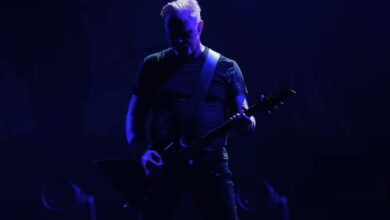Slayer Ignited a Frenzied Uprising with a Relentless “Angel of Death” in Front of 35,000 at Cardiff Blackweir Fields 2025
Slayer’s return to the UK stage after a six-year hiatus felt like an earthquake hitting Cardiff’s Blackweir Fields on July 3, 2025. As the thrash titans took the stage, the opening notes of South of Heaven ignited a collective roar among the 35,000-strong crowd. Flames lit up the night sky as the first wave of pyro crashed in perfect synch to the pounding drums—pure, visceral thrash energy unleashed at full throttle.
Legendary frontman Tom Araya, sporting his trademark grin and a few more grey streaks, took a moment to reminisce: “Forty years ago, dude… Duuude,” he mused, taking fans back to Slayer’s debut UK gig at London’s Marquee in 1985. Those stalwarts at the front—some still alive from that evening—bellowed back in affirmation, proof that both band and audience had aged like fine wine… or perhaps, in true Slayer fashion, fine whiskey steeped in aggression.
Despite a stacked supporting lineup, scheduling constraints meant quick set changes for Hatebreed, Mastodon, Anthrax, and Amon Amarth before Slayer headlined. Amon Amarth’s brutal Viking chant may have warmed hearts, but Cardiff knew what they came for: the ceremonial execution of thrash royalty. Once Slayer hit Jihad, the crowd became a living beast, its collective headbanging a testament to the band’s unrelenting legacy.
By the time War Ensemble and Chemical Warfare hit, Kerry King and Gary Holt tore into dual-guitar harmonics, their blistering solos slicing through the night air like razor wire. Some described it as “like witnessing sitar masters of malevolence”—poetic but accurate. Each chord felt heavy enough to shatter skulls, yet melodic enough to leave fans joyous in their punishment.
When the inverted Marshall-cab crosses erupted in flames during Disciple, the crowd gasped, caught off guard by both intensity and theatrics. Pyrotechnics had always been part of Slayer’s live DNA, but here it felt earned, ritualistic—an offering to the gods of old-school metal. It wasn’t just a show; it was sacrament.
Mid-set, Tom paused to challenge the crowd: “Which of you were there in ’85?” A hush fell, then chants of “Slayer! Slayer!” rippled through. In that moment, time collapsed: the sweaty, graffiti-splattered basements of the Eighties merged with the festival fields of 2025. A visceral, multi-generational communion.
Seasons in the Abyss offered a slight melodic reprieve, yet never softened the blow. Under its swirling riffs, the crowd moved like a dark tide, beautiful in its brutality. Even amidst pyrotechnic storms and ripped-apart speakers, Slayer reminded us that complexity and chaos are not mutually exclusive.
By the encore, Raining Blood summoned a cinematic storm: digital backdrops bled crimson blood, synced to every drum hit, every guitar slash. When the chorus hit, the sea of arms rose like branches in a storm—an audience drenched in suspicion, power, and undeniable loyalty.
But it was the closing Angel of Death that truly marked the ritual’s climax. The riff that birthed generations echoed across Cardiff. Bodies hurled, fists pumped, and by the final note, the crowd stood unbroken—exhausted, exhilarated, and erased all at once.
Backstage stories whispered of the band’s chemistry: King and Araya vibed like old warlords reunited, Holt and Bostaph locking into a deadly groove that belied their age. In their sixties, yet still sprinting, their relentless drive proved age really is just a number when thrash pulses in your veins.
While local fans grumbled about door chaos—security delays meant some missed opening acts—it hardly mattered. When Slayer hit, everything coalesced. Fans on Reddit joked, “It took longer to enter than Hatebreed played,” but all agreed: every second in Blackweir Fields was earned by Slayer’s sonic onslaught.
The show wasn’t flawless—set times were tight, the schedule brutal, and logistics sometimes felt like herding wolves—but those imperfections became part of the legend. The grit, the crowd’s sweat, the distant roar of Cardiff Castle looming—all fused into a perfect metal storm.
In the aftermath, articles called it “spectacle, gore, mayhem and some of metal’s greatest songs,” echoing what every fan felt: this wasn’t a comeback, it was a homecoming. A brutal, beautiful ceremony of loyalty between band and fans that refused to die.
And Slayer’s return sets a date with destiny: next stop Birmingham for Sabbath’s finale, then London’s Finsbury Park. But Cardiff—this night—is its own epoch, an indelible memory stamped into the metal annals, where Angel Of Death ascended from song to legend under a sky of fire.
After six years of silence, Slayer didn’t whisper—they roared. If metal is a living creature, Cardiff was its heart, pumping lifeblood into every riff, every scream. Not just a gig, but a historic, hellraising testament: Slayer’s flame still burns, untamed, unstoppable, eternal.





